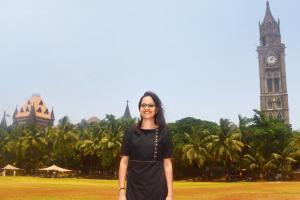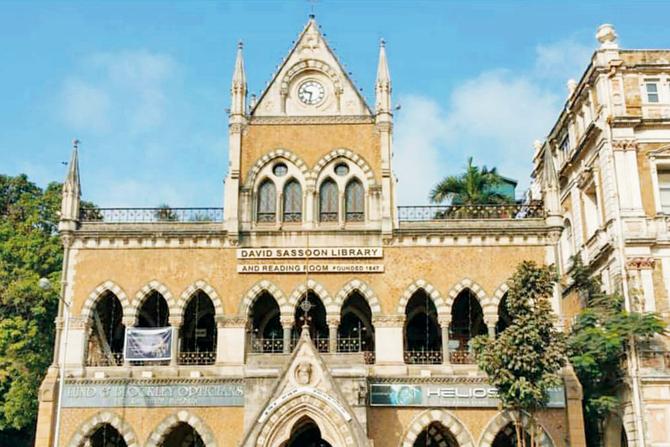After Victorian Gothic and Art Deco ensembles were declared as a World Heritage Site by UNESCO, a new foundation in South Mumbai works towards protecting them

Apoorva Iyengar stands between the 19th-century Victorian Gothic structures of the Bombay High Court and the Rajabai Clock Tower. Pic/Atul Kamble
From the late 1800s, Mumbai implemented an ambitious urban planning project, which resulted in the construction of two ensembles of public buildings bordering the Oval Maidan: first, in the Victorian Neo-Gothic style, and later, in the Art Deco idiom. While the Victorian ensemble includes Indian elements suited to local weather conditions, the Art Deco ones flaunt a style of their own. They exhibit an important exchange of European and Indian human values during that time, says Apoorva Iyengar, a conservation architect, who shares lesser-known trivia about them on Instagram, @mumbai.world.heritage.
On June 30, 2018, the Federation of Residents Trusts (FORT) Foundation was formed, of which Iyengar is an active member. It was started by members of the Nariman Point Churchgate Citizens Association (NPCCA), Art Deco Mumbai Trust (ADMT), Oval Cooperage Residents Association (OCRA), Kala Ghoda Association (KGA), Urban Design Research Institute (UDRI) and Organisation for Verdant Ambience and Land Trust (OVAL Trust) along with NGO Nagar. The same day, UNESCO declared Mumbai's Victorian and Art Deco ensembles as World Heritage Site. These include the city, civil and sessions courts, the Western Railway headquarters, CSMVS and Eros and Regal cinema halls, among several others. "FORT has taken up issues related to the UNESCO-inscribed World Heritage Site," says Iyengar. "It aims to work at meeting the compliance requirements of the heritage area in South Mumbai, where 94 ensembles are located. The project will help craft planning policies and other measures to ensure that the World Heritage inscription is upheld in the future."
ADVERTISEMENT

The David Sassoon Library and Reading Room was initially built as a Mechanic's Institute. Artwork Source/David Sassoon Library
Earlier this month, FORT rolled out the Instagram account. Here, Iyengar posts photographs, drawings and historical facts of the 94 structures. "General awareness about these sites needs to reach the public, and what better way to do this than Instagram? The idea envisioned by me was that each of these buildings is still being used by the public and is a powerful narrative of the city's past. The different architectural styles of these structures and the cultural exchange that took place here are incredible. Our Instagram page, thus, aims to start a discussion around these heritage sites."
When asked of her favourite bit of trivia, she says, "The Watson Hotel is the oldest surviving cast-iron structure in the country. Parts of the building were bought in Britain and shipped to Mumbai. But, not many people know this. Similarly, the CSMVS combines Hindu and Saracenic architectural forms, along with Western elements of architecture. Architect George Wittet designed the dome after the Gol Gumbaz in Bijapur, and copied the finial from the Taj Mahal. He incorporated the original wooden arched pavilion purchased from a royal wada [house] in Nashik, as a circular railing on the first floor of the museum. It is fascinating what stories these structures have left behind for us."

While Iyengar captures pictures and sources original drawings of these sites for the Instagram page, two other core members, Nayana Kathpalia and Atul Kumar, ideate on maintaining the ensembles. FORT is neither employed by UNESCO nor by the state government, but works as a mediator to ensure these sites continue to stand tall for the next generation to remember the city's rich past. "UNESCO gives out a list of recommendations to be worked on immediately. It is the state government's duty to implement these ideas. FORT's job is to intervene every time such works are stalled." At present, FORT is working on two major projects. "In Art Deco sites, the facades are very important. We are checking if regulations can be put in place to maintain the height of the buildings. We will then formulate guidelines and present them before government bodies, who will take a final call. Additionally, we want all 94 structures to be listed. Once a property is graded, there are certain regulations under which they will be protected. Grade I buildings are of highest importance and cannot be touched, while Grade II structures can undergo sensitive alterations."
What: Mumbai's UNESCO World Heritage Site
Instagram: @mumbai.world.heritage
Catch up on all the latest Mumbai news, crime news, current affairs, and also a complete guide on Mumbai from food to things to do and events across the city here. Also download the new mid-day Android and iOS apps to get latest updates
 Subscribe today by clicking the link and stay updated with the latest news!" Click here!
Subscribe today by clicking the link and stay updated with the latest news!" Click here!







